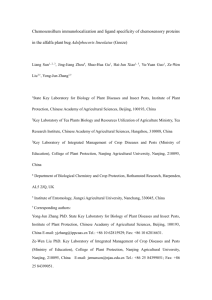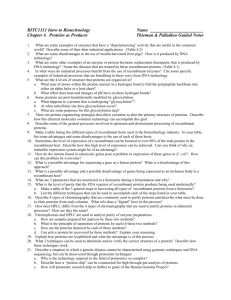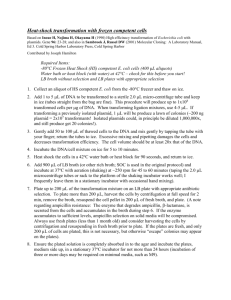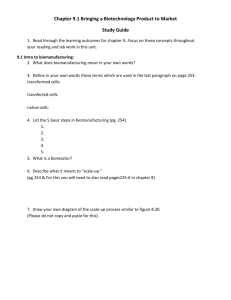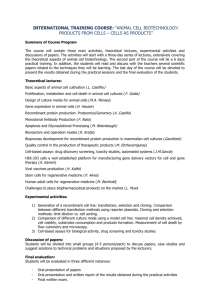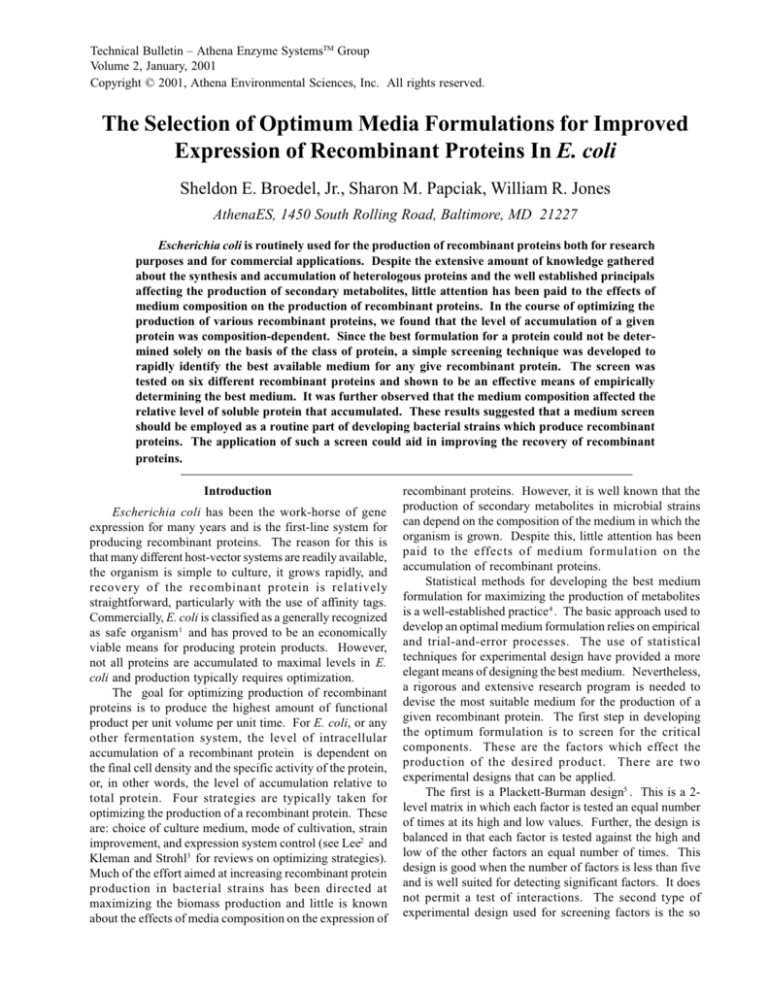
Technical Bulletin Athena Enzyme SystemsTM Group
Volume 2, January, 2001
Copyright © 2001, Athena Environmental Sciences, Inc. All rights reserved.
The Selection of Optimum Media Formulations for Improved
Expression of Recombinant Proteins In E. coli
Sheldon E. Broedel, Jr., Sharon M. Papciak, William R. Jones
AthenaES, 1450 South Rolling Road, Baltimore, MD 21227
Escherichia coli is routinely used for the production of recombinant proteins both for research
purposes and for commercial applications. Despite the extensive amount of knowledge gathered
about the synthesis and accumulation of heterologous proteins and the well established principals
affecting the production of secondary metabolites, little attention has been paid to the effects of
medium composition on the production of recombinant proteins. In the course of optimizing the
production of various recombinant proteins, we found that the level of accumulation of a given
protein was composition-dependent. Since the best formulation for a protein could not be determined solely on the basis of the class of protein, a simple screening technique was developed to
rapidly identify the best available medium for any give recombinant protein. The screen was
tested on six different recombinant proteins and shown to be an effective means of empirically
determining the best medium. It was further observed that the medium composition affected the
relative level of soluble protein that accumulated. These results suggested that a medium screen
should be employed as a routine part of developing bacterial strains which produce recombinant
proteins. The application of such a screen could aid in improving the recovery of recombinant
proteins.
Introduction
Escherichia coli has been the work-horse of gene
expression for many years and is the first-line system for
producing recombinant proteins. The reason for this is
that many different host-vector systems are readily available,
the organism is simple to culture, it grows rapidly, and
recovery of the recombinant protein is relatively
straightforward, particularly with the use of affinity tags.
Commercially, E. coli is classified as a generally recognized
as safe organism 1 and has proved to be an economically
viable means for producing protein products. However,
not all proteins are accumulated to maximal levels in E.
coli and production typically requires optimization.
The goal for optimizing production of recombinant
proteins is to produce the highest amount of functional
product per unit volume per unit time. For E. coli, or any
other fermentation system, the level of intracellular
accumulation of a recombinant protein is dependent on
the final cell density and the specific activity of the protein,
or, in other words, the level of accumulation relative to
total protein. Four strategies are typically taken for
optimizing the production of a recombinant protein. These
are: choice of culture medium, mode of cultivation, strain
improvement, and expression system control (see Lee2 and
Kleman and Strohl3 for reviews on optimizing strategies).
Much of the effort aimed at increasing recombinant protein
production in bacterial strains has been directed at
maximizing the biomass production and little is known
about the effects of media composition on the expression of
recombinant proteins. However, it is well known that the
production of secondary metabolites in microbial strains
can depend on the composition of the medium in which the
organism is grown. Despite this, little attention has been
paid to the effects of medium formulation on the
accumulation of recombinant proteins.
Statistical methods for developing the best medium
formulation for maximizing the production of metabolites
is a well-established practice 4 . The basic approach used to
develop an optimal medium formulation relies on empirical
and trial-and-error processes. The use of statistical
techniques for experimental design have provided a more
elegant means of designing the best medium. Nevertheless,
a rigorous and extensive research program is needed to
devise the most suitable medium for the production of a
given recombinant protein. The first step in developing
the optimum formulation is to screen for the critical
components. These are the factors which effect the
production of the desired product. There are two
experimental designs that can be applied.
The first is a Plackett-Burman design5 . This is a 2level matrix in which each factor is tested an equal number
of times at its high and low values. Further, the design is
balanced in that each factor is tested against the high and
low of the other factors an equal number of times. This
design is good when the number of factors is less than five
and is well suited for detecting significant factors. It does
not permit a test of interactions. The second type of
experimental design used for screening factors is the so
Medium Formulations for Improved Expression of Proteins
Technical Bulletin Vol. 2
Table 1. Bacterial strains.
Strain Name
AES-None
AES-MalE
AES-GST
AES-GFP
AES-I278
AES-TesA
AES-LypA
Protein
Bacterial Strain
None
JM109
Maltose binding protein
JM109
Glutathione S-transferase
JM109
Green fluorescent protein
JM109
Synthetic polyprotein of titin I27 domain
M15
Thioesterase I (EC 3.1.1.5) of E. coli
M15
Lysophospholipase B (EC 3.1.1.5) of Vibrio cholerae
M15
Vector
pUC19
pMalc2
pGEX2T
pGFP
pI278
pTesA
pLypA
Promoter
lacp
tac
tac
lacp
T5p
T5p
T5p
(St. Louis, MO) or USBiological (Marblehead, MA). The
media employed were manufactured by Athena Enzyme
TM
Systems of AthenaES (Baltimore, MD). The media
TM
included LB Broth (Miller), Glucose M9Y, Turbo Broth ,
TM
TM
TM
Power Broth , Superior Broth and Hyper Broth .
Bacterial strains and vectors. Table 1 lists the
bacterial strains and plasmid vectors used to produce the
recombinant proteins. The strains were cultured on solid
TYE medium: 10g/L Tryptone, 5 g/L yeast extract, 8 g/L
NaCl, 15 g/L microbiology grade agar supplemented with
ampicillin to 100 µg/ml. The bacterial hosts were JM109
(recA, endA1, gyrA96, thi, hsdR17, supE44, relA1, D(lacproAB), F traD36, proAB, lacIqZDM15) and M15 (Qiagen,
Valencia, CA). Plasmids pMalc2 (New England BioLabs,
Inc., Beverly, MA), pGEX2T (Amersham-Pharmacia,
Piscataway, NJ) and pGFP (Clontech Laboratories, Inc.,
Polo Alto, CA) express the maltose binding protein (MalE),
glutathione S-transferase (GST) and Aequorea victoria
green fluorescent protein (GFP), respectively. AES-I278
produces a synthetic polyprotein composed of repeating
human titin protein domains 8 . Plasmid pTesA was
constructed by ligating the PCR amplified coding sequence
of the tesA gene of E. coli9 into pTrc99A (AmershamPharmacia, Piscataway, NJ) at the NcoI/EcoRI restriction
sites of the vector. Plasmid pLypA was made by ligating
the PCR amplified coding sequence of lypA from Vibrio
cholera10 into pQE31 (Qiagen, Valencia, CA) at the BamHI/
PstI sites. This construction added a poly-His tag to the
amino-terminus of the LypA protein to facilitate purification
of the enzyme.
Media screen. Overnight cultures were inoculated
with a single colony of the recombinant strain into 2 ml of
LB (Miller) Broth in a shake flask and incubated at 37°C.
The overnight culture (0.1 ml) was used to inoculate 2 ml
TM
of each of the six media of the Media Optimization Kit
which included Glucose M9Y, LB Broth (Miller), Hyper
TM
TM
TM
TM
Broth , Power Broth , Superior Broth and Turbo Broth
in six well culture dishes. The cultures were incubated at
37°C with shaking at 250 rpm until the OD600 reached 0.6
(about 2 h). Expression of the recombinant protein was
induced by the addition of IPTG to 1 mM and the incubation
continued for 3 h. A 1 ml sample was removed, the cells
harvested by microfuging for 5 min., and the cells suspended
in water to give 1.0 OD600 per ml. The cell suspension was
stored at -20°C.
called fractional factorial design6 . This is again a 2-level
matrix design which can measure interactions. The factors
are set at two levels, a high and a low, and consists of 2k-p
trials where k is the number of factors and (1/2)p is an integer
of the fraction of full factorials. The main utility of this
technique is that the main effects along with interactions
can be examined.
Once the critical factors are determined, optimization
can begin. First, curvature of the main effects is assessed
by running replicate mid-points of the factor settings. If
the mean of the mid-point outcome exceeds the mean of
the factorial points the optimum is within the design space.
Alternatively, if the mid-point mean is lower than the mean
of the factorial points, then the optimum is outside the
design space. The non-critical factors are set at their midpoints or on the best values based on the data. Mathematical
models are then employed to describe the optimal process.
Statistical software packages are available which greatly
simplify this process. Typically, 2 to 5 factors are examined
at 3 or 5 factor settings. A response surface modeling design
is then used to develop the model7 . The model developed
predicts the optimal values for the factors in question which
are tested in subsequent rounds of experimentation.
In the course of optimizing the production of proteins
in E. coli we developed a set of media formulations that
consistently increase the accumulation of recombinant
proteins above the more traditional LB Broth recipe. Our
observations have been that not all proteins are maximally
expressed in any one medium. Rather, each protein
accumulates to different levels in different media and it
has not been possible to predict which medium would be
most suitable for any given protein. Therefore, we devised
a media optimization screen in which the production of a
recombinant protein is examined when the host strain is
grown in each of six media formulations. This simple and
rapid screen allows for the selection of the most suitable
medium for any given protein without laborious screening
for the critical factors and subsequent optimization research.
In this paper, we describe the use of a media screen as a
means of identifying the most suitable medium for the
production of recombinant proteins in E. coli.
Materials and Methods
Chemicals. Chemicals and buffers were purchased
from BD Biologicals (Baltimore, MD), Sigma Chemical
2
Medium Formulations for Improved Expression of Proteins
SDS-PAGE. SDS-PAGE analysis was performed using
8-16% Tris-glycine acrylamide gradient gels (Novex, San
Diego, CA). The culture samples were prepared by mixing
25 µl of 2x loading dye with 25 µl of each cell suspension.
The solutions were mixed well and heated at 100°C for 5
min. To each lane of the gel, 10 µl of dye-sample mixture
was loaded and the electrophoresis performed in SDS-TrisGlycine buffer at 130 V constant until the dye front reached
the bottom of the gel. The protein bands were stained with
TM
GelCode Blue (Pierce Chemical).
Esterase assays. Enzymatic activity was measured in
cell-free extracts or toluenized cells. The extracts were
prepared using a lysozyme/freeze-thaw method. A 250 µl
aliquot of each cell suspension was incubated with 250 µg
lysozyme for 1 hour on ice. After three rounds of freezing
in a dry ice/ethanol bath and thawing at 37°C, the extracts
were incubated with 10 units DNaseI for 30 min on ice.
The extracts were clarified by centrifugation at 12,000 xg
for 10 min. and stored at 4°C. The protein concentration
was determined using the Bradford dye-binding assay11 .
Toluenized cells were prepared as described12 .
Thioesterase activity was determined as described by
Cho and Cronan13 using a microplate format. To duplicate
TM
wells of a 96-well microtiter dish (PolySorp , Nunc), 10
µl of cell-free extract or tolueninzed cells was mixed in 90
µl 50 mM potassium phosphate buffer pH 7.5. The reaction
was started by adding 100 µl 2x reaction cocktail which
was composed of 125 mM potassium phosphate buffer pH
7.5, 250 mM deconyl-CoA, 250 mM 5, 5-dithio-bis(2nitrobenzoic acid). The increase in absorbance at 405 nm
over a 10 min. period was monitored using a UVMax
microplate reader (Molecular Devices). Reaction rates were
calculated from the initial rate curves.
Carboxylesterase activity was determined using pnitrophenyl butyrate according to Stoops et al.14 using a
microplate format. To duplicate wells containing 90 µl of
50 mM potassium phosphate buffer pH 7.5, 10 µl of crude
extract was added, mixed well, and 100 µl 100 mM onitrophenyl butyrate added. The increase in absorbance at
405 nm was monitored spectrophotometrically. The initial
reaction rate was calculated from the first 2-4 min of the
reaction.
Technical Bulletin Vol. 2
liter could be achieved if the most suitable formulation could
be identified.
To examine the effect of media composition on the
production of each of six recombinant proteins, the relative
level of expression was analyzed using the six different
media formulations. The respective cultures were grown
and expression induced with IPTG as described in the
Materials and Methods section. The synthesis of the
recombinant proteins was induced at equal cell densities
with the cells in exponential growth phase. This eliminated
effects caused by differences in expression due to cell growth
stage. Nonetheless, the final cell densities were different
due to the different growth-rates achieved in each of the
media. Recombinant protein accumulation relative to total
protein was assessed by SDS-PAGE. Each lane of the gel
was loaded with an equal amount of protein. Thus, observed
differences in the stain intensity of the recombinant protein
reflects a higher or lower level of accumulation relative to
total protein. In this way qualitative differences in the
specific activity of each protein could be measured.
Figure 1 shows the SDS-PAGE analyses of six
recombinant proteins. Each panel shows the result of
expressing a different recombinant protein in each of the
six media of the screening kit. Panel A is the reference
strain which does not harbor a plasmid expressing a
recombinant protein. In this strain, differential expression
was observed for several proteins, clearly indicating that
differences in media formulation affects the expression of
host genes. As expected, due to the nature of the protein
and differences between the various expression vectors
employed, the level of production of each protein was
different. In each case variations in the relative level of
accumulation were observed between the different media
for a given protein. For example, MalE was maximally
TM
accumulated when grown in Power Broth , GST in Hyper
TM
TM
TM
Broth , GFP in Turbo Broth , I278 in Superior Broth ,
TM
and LypA in Power Broth . Accumulation of GFP was
TM
not observed in glucose M9Y, Hyper Broth or Superior
TM
Broth grown cells. Similarly, LypA was not observed in
glucose M9Y grown cells. In contrast, MalE and GST were
expressed well in glucose M9Y. In all cases, LB Broth was
not the medium yielding the highest level of recombinant
protein accumulation. These data show that medium
composition has a significant effect on the accumulation of
recombinant proteins and, importantly, that the
Results
Table 2 lists the typical wet weight yields of JM109
grown in each of the media using shake flask cultures. Each
of the four media specially formulated to increase the
production of recombinant proteins, Hyper BrothTM, Power
BrothTM, Superior BrothTM and Turbo BrothTM, gave higher
biomass yields than the reference medium, LB Broth. If
the levels of accumulation of recombinant proteins are the
same and independent of media composition, then the
increase in biomass yields alone will serve to increase the
production of a given recombinant protein. Thus, if the
medium composition were to increase the relative level of
accumulation of a given protein, then a higher yield per
Table 2. Biomass yields (wet weight) in each of the six
medium.
Medium
Glucose M9Y
LB Broth
Hyper BrothTM
Power BrothTM
Superior BrothTM
Turbo BrothTM
3
Biomass Yield (g/L)
16
10
36
24
18
30
Medium Formulations for Improved Expression of Proteins
A
B
C
D
Technical Bulletin Vol. 2
E
F
G
Figure 1. SDS-PAGE analysis of total protein from each strain in Table 1. Samples were prepared as described in the Materials and
Methods section. Panel A - reference strain without a recombinant protein; Panel B to G - MalE, GST, GFP, I278, TesA, LypA,
respectively. Arrows denote the location of the respective protein. Marker proteins are shown to the left and right of each set of cellular
TM
TM
proteins. From left to right in each panel are samples from cells grown in Glucose M9Y, LB (Miller), Hyper Broth , Power Broth ,
TM
TM
Superior Broth and Turbo Broth .
accumulation of various recombinant proteins may be
affected differently.
TesA polypeptide could not be identified by SDSPAGE. Because TesA is expressed with its signal sequence,
it is likely to be exported to the periplasmic space. This
would limit the amount of protein that can accumulate and
levels of the protein would not be expected to be dramatically
higher than in the wild-type strain. As shown in Figure 2,
however, expression of the protein above wild-type levels
was observed when a functional assay was used to track
protein accumulation. Thioesterase activity was detected
in all extracts from cells grown in all of the six media.
Accumulation was highest, 2.5-fold above that in LB Broth,
TM
TM
in glucose M9Y, Power Broth and Turbo Broth . A
similar pattern of expression was observed in toluenized
cells (Fig. 2).
LypA was observed to be accumulated as an insoluble
product. Microscopic inspection of post-induction cells
revealed prominent inclusion bodies. Further, the protein
was observed in the insoluble fraction of lysed cells. LypA
enzymatic activity was measured in cell-free extracts as a
means of determining whether a portion of the enzyme was
in the soluble fraction and retained function (LypA has not
been demonstrated to have thioesterase activity, therefore,
only the carboxylesterase activity was assayed). Significant
levels of enzyme activity (55,800 Units/mg compared to
non-detectable in control cells) were detected in the extract
TM
prepared from cells cultured in Hyper Broth (Fig. 3).
Some activity, about 6-fold above endogenous levels, was
detected in extracts from cells grown in glucose M9Y and
TM
Turbo Broth . However, the specific activity was 1/6 of
TM
that found in Hyper Broth grown cells. Interestingly,
TM
Hyper Broth did not yield the highest level of protein
accumulation. In fact, it ranked second to last (Fig. 1 Panel
TM
G). Glucose M9Y and Turbo Broth ranked last and third
to last, respectively, for relative LypA accumulation.
Importantly, the amount of protein produced in Glucose
M9Y grown cells was not readily visible in SDS-PAGE
analysis whereas it was for the other two media. These
results contradict the general rule that the amount of
insoluble product formed by hyper-expressed proteins can,
in some cases, be decreased by lowering the level of
expression. Rather, it would seem that the composition of
the medium not only affects the amount of recombinant
protein accumulated, but it also affects the relative fraction
that remains soluble.
30000
20000
Turbo Broth
Superior Broth
Pow er Broth
Hyper Broth
0
LB Broth
10000
Glucose M9Y
Thioesterase activity
µ moles/min/ml)
(µ
40000
Discussion
Medium
The medium composition-dependent accumulation of
recombinant proteins has several implications. As the data
clearly demonstrated, each recombinant protein was
expressed to different levels in different media suggesting
that there is a relationship between each protein and the
composition of the medium in which it is produced. In the
Figure 2. TesA thioesterase activity in crude extracts prepared
from cells grown in the six different media. Thioesterase activity
was measured as described in the Materials and Methods section.
Left bars are the activity found in toluenized cells and the right
bars activity found in the soluble fraction of lysed cells.
4
Medium Formulations for Improved Expression of Proteins
accumulation of recombinant proteins as insoluble products
is a major shortcoming to using E. coli-based expression
systems. In the example of LypA production, the increased
amount of soluble protein, as judged by functional activity,
did not follow the rule of more total product gives more
soluble product. In fact, the amount of soluble protein could
not be predicted by the relative level of LypA accumulation.
While this report only presents one example, recent work
by others found a similar result for the Candida albicans
TM
glucosyltransferase where Power Broth was found to yield
soluble product whereas the other media did not17 . Other
approaches reported to increase the relative accumulation
of soluble protein included lowering the temperature during
induction18 ,19 ,20 , reducing the concentration of inducer 21 ,22 ,
using mutant strains which affect protein folding23 , fusing
the target protein to a bacterial protein24 ,25 ,26 , and employing
a variety of molecular chaperones27 . Each of these factors
is believed to affect protein folding in one way or another.
The subject of recombinant protein folding is reviewed by
Baneyx28 . It now seems that medium compositon may affect
protein folding too. Most likely the effect is through
modulation of expression of the chaperones or accessory
proteins involved in protein folding. Since a given
chaperone only works on a subset of proteins it is reasonable
to suggest that for any given recombinant protein the set of
chaperones which influences its folding may or may not be
at sufficient levels in any given medium. Until all of the
chaperone-protein interactions have been defined, it remains
beyond the scope of current knowledge to predict which set
of chaperones are needed to correctly fold a protein and
thus impossible to determine in advance which medium
formulation is most suitable for the target protein.
Therefore, the best medium must be determined empirically.
The described media screen should aid in simplifying this
process.
Control
TesA
LypA
2.0×10 05
Turbo Broth
Superior Broth
Power Broth
Hyper Broth
0.0×10 -00
LB Broth
1.0×10 05
Glucose M9Y
Specific Activity
(µ moles/min/mg)
3.0×10 05
Technical Bulletin Vol. 2
Medium
Figure 3. Specific activity of LypA and TesA in cell-free extracts
after 3 hours induction with IPTG. Carboxyesterase activity was
measured using ρ−nitrophenyl butyerate substrate as described in
the Materials and Method section.
extreme case, the selection of one medium over another
could be the difference between production and no
production. The type of protein or its original source does
not appear to predict which composition is most suitable.
The medium producing the highest level of biomass also
does not predict product accumulation. In our laboratory,
TM
Hyper Broth gives the highest biomass yields, yet as shown
above, this medium does not lead a priori to the highest
level of recombinant protein accumulation. Consequently,
a screen of several media formulations to determine which
yields the best level of production would be advisable.
Despite the history of employing LB medium for the
cultivation of E. coli, this is not necessarily the medium of
choice for the production of recombinant proteins. LB does
not contain a buffering system. Therefore, its use in a
fermentation system, particularly with feed-batch or
continuous culture protocols, is limited. Typically, buffered
media formulations are employed in fermentations and most
traditional fermentation media are of defined
compositions15 ,16 . Thus, when LB is used in a bench-scale
setting to produce recombinant proteins, a different medium
must be employed when the production is shifted to a
fermentor. This requires additional research work to
determine the best medium composition. While it can be
argued that such work is necessary when regulatory
compliance for commercial production is an issue, for most
research and development, pre-clinical or pre-commercial
work, this is an unnecessary expense. Selecting a more
suitable medium which is more readily scalable, as is the
TM
TM
case with Glucose M9Y, Hyper Broth , Power Broth
TM
TM
Superior Broth and Turbo Broth (all of which have a
buffering system), reduces the time and effort needed to
scale the protein production.
The observation that the medium composition can affect
the accumulation of soluble protein is significant. The
References
1. Guidelines for Research Involving Recombinant DNA
Molecules, January 2001, Office of Biotechnology
Activities, National Institutes of Health, http://
www4.od.nih.gov/oba/rac/guidelines/guidelines.html.
2. Lee, S. Y. 1996. High Cell-density culture of
Escherichia coli. Tibtech 14:98-105.
3. Kleman, G. L. and W. R. Strohl. 1994. Development
in high cell density and high productivity microbial
fermentation. Current Opinion in Biotech. 5:180-186.
4. Strobel, R. J. and G. R. Sullivan. 1999. Experimental
design for improvement of fermentations. In Manual of
industrial Microbiology and Biotechnology, A. L. Demain
and J. E. Davies, eds., ASM Press, Washington, DC, pp.
80-93.
5. Plackett, R. L., and J. P. Burman. 1946. The design of
optimum multifactorial experiments. Biometrika 33:305325.
5
Medium Formulations for Improved Expression of Proteins
6. Haaland, P. d. 1989. Experimental Design in
Biotechnology. Marcel Dekker, Inc., New York, NY.
Technical Bulletin Vol. 2
20. Cabilly, S. 1989. Growth at sub-optimal temperatures
allows the production of functiona, antigen-binding Fab
fragment in Escherichia coli. Gene 85:553-557.
7. Box, G. E. and N. R. Draper. 1987. Empirical ModelBuilding and Response Surfaces. John Wiley & Sons, Inc.,
New York, NY.
21. Takagi, H. Y. Morinaga, M. Tsuchiya, H. Ikemura, and
M. Inouye. 1988. Control of folding of protein secreted by
high expression secretion vector, pINIIIompA: 16-fold
increase in production of active subtilisin E in Escherichia
coli. BioTechnology 6:948-950.
8. Carrion-Vazquez M., A.F. Oberhauser, S.B. Fowler,
P.E. Marszalek, S.E. Broedel, Jr. J. Clarke, and J.M.
Fernandez. 1999. Mechanical and chemical unfolding of a
single protein: a comparison. Proc Natl Acad Sci U S A.
96(7):3694-3699.
22. Vasina, J. A. and F. Baneyx. 1997. Expression of
aggregation-prone recombinant proteins at low temperature:
a comparative study of the Escherichia coli cspA and tac
promoter systems. Protein Expr. Purif. 9:211-218.
9. Cho, H. and J. E. Cronan, Jr. 1993. Escherichia coli
thioesterase I, molecular cloning and sequencing of the
structural gene and identification as a periplasmic enzyme.
J. Biol. Chem. 268(13):9238-9245.
23. Miroux, B. and J. E. Walker. 1996. Over-production
of protein in Escherichia coli: mutant hosts that allow
synthesis of some membrane proteins and globular proteins
at high levels. J. Mol. Biol. 260:289-298.;
10. Whayeb, S. A., K. Yamamoto, H. Tojo, T. Honda. 1996.
Genetic analysis of the chromosomal region encoding
lysophospholipase L2 of Vibrio cholerae O1. Biochim.
Biophys. Acta 1300:1-4.
24. Kapust, R. B. and D. S. Waugh. 1999. Escherichia
coli maltose-binding protein is uncommonly effective at
promoting the solubility of polypeptides to which it is fused.
Protein Sci. 8:1668-1674.
11. Bradford. M. M. 1976. A rapid and sensitive method
for the quantitation of microgram quantities of protein
utilizing the principle of protein-dye binding. Anal.
Biochem. 72:248-254.
25. Forrer, P. and R. Jaussi. 1998. High-level expression
of soluble heterologous protein in the cytoplasm of
Escherichia coli by fusion to the bacteriophage lambda head
protein D. Gene 224;45-52.
12. Schleif, R. F. and P. C. Wensink. 1981. Practical
Methods in Molecular Biology. Springer-Verlag, New York,
NY.
26. Sachdev, D. and J. M. Chirgwin. 1998. Order of fusions
between bacterial and mammalian protein can determine
solubility in Escherichia coli. Biochem. Biophys. Res.
Commun. 244:933-937.
13. Cho, H. and J. E. Cronan, Jr. 1993. Escherichia coli
thioesterase I, molecular cloning and sequencing of the
structural gene and identification as a periplasmic enzyme.
J. Biol. Chem. 268(13):9238-9245.
27. Baneyx, F. 1999. Recombinant protein expression in
Escherichia coli. Current Opinion in Biotechnology.
10:411-421.
14. Stoops, J.K., D.J. Horgan, M.T. Runnegar, J. De Jersey,
E.C Webb, and B. Zerner. 1969. Carboxylesterases (EC
3.1.1). Kinetic studies on carboxylesterases. Biochemistry
8(5):2026-2033.
28. Baneyx. F. 1999. In vivo folding of recombinant
proteins in Escherichia coli. In Manual of Industrial
Microbiology and Biotechnology, A. L. Demain and J. E.
Daves, eds., ASM Press, Washington, DC, pp. 551-565.
15. Trilli, A. 1986. Scale-up fermentations. In Manual of
Industrial Microbiology and Biotechnology, A. L. Demain
and N. A. Solomon, eds., ASM Press, Washington, DC,
pp. 277-307.
16. Hosobuchi, M. and H. Yoshikawa. 1999. Scale up of
microbial processes. In Manual of Industrial Microbiology
and Biotechnology, A. L. Demain and J. E. Daves, eds.,
ASM Press, Washington, DC, pp.236-239.
17. McElheny-Feser, G. and R. L. Cihlar, Georgetown
University, personal communication.
18. Piatak, M., J. A. Lane, W. Laird, M. J. gjorn, A. Wang,
and M. Williams. 1988. Expression of soluble and fully
functional ricin A chain in Escherichia coli. J. Biol. Chem.
263:4837-4843.
19. Schein, C. H., and M. H. M. Noteborn. 1988. Formation
of soluble recombinant proteins in Escherichia coli is
favored by lower growth temperatures. BioTechnology
6:291-294.
6
Medium Formulations for Improved Expression of Proteins
Call for a catalogue,
or visit our web site at
www.athenaes.com
to download a copy.
Telephone Ordering:
Technical Bulletin Vol. 2
1-888-892-8408 Toll Free
410-455-6319 in Maryland
Fax Ordering:
410-455-1155
Email Ordering:
media@athenaes.com
Ordering Information
Product
TM
Media Optimization Kit
Unit Size
1 kit
2 kits
6 kits
Cat. No.
0100-1
0100-2
0100-6
LB (Miller)
500 g
2pack
6pack
0101-1
0101-2
0101-6
LB (Lennox)
500 g
2pack
6pack
0102-1
0102-2
0102-6
500 g
2pack
6pack
0103-1
0103-2
0103-6
500 g
2pack
6pack
0104-1
0104-2
0104-6
Superior Broth
500 g
2pack
6pack
0105-1
0105-2
0105-6
Power BrothTM
500 g
2pack
6pack
0106-1
0106-2
0106-6
Hyper BrothTM
500 g
2pack
6pack
0107-1
0107-2
0107-6
Glucose M9Y
500 g
2pack
6pack
0108-1
0108-2
0108-6
LB (Luria)
Turbo Broth
TM
TM
To place an order please provide the following information:
1. Institution name and customer account number.
2. Purchase Order number.
3. Catalogue number of item(s) being ordered and
the quantity.
4. Billing and shipping addresses.
5. Contact name and telephone number for order
matters.
Delivery:
Telephone orders received Monday through Friday
before 12 noon will be shipped that day. All other orders
will be shipped the next business day, unless otherwise
stipulated.
Shipping Charges:
Shipping charges are prepaid and added to the invoice.
Shipping is via UPS unless otherwise requested. Please
inquire about rates to your location.
Discounts:
All customers will receive a 10% discount on orders of
six (6) or more units of media. Mix and Match Six Packs
are available (see above for details). For customers wishing to make purchases totaling more than 54 units, a stocking discount rate of 25% is available (see Institutional Stocking Orders above for details).
7
Medium Formulations for Improved Expression of Proteins
International Distributors
Technical Bulletin Vol. 2
India
ELPHO Medical & Electronics (P) Ltd.
# 111, 13th cross, 22nd Main,
Raghavendra Layout, Padmanabhanagar
Bangalore 560 070. Karnataka India
Telephone/Fax: ++91.80.6692263
Mobile: 98450-92477
Email: elpho.csrajesh@mantraonline.com
Canada
InterScience
169 Idema Road
Markham, Ontario
L3R 1A9 Canada
Tel: 905-940-1831
Fax: 905-940-1832
info@interscience.com
URL: www.InterScience.com
Europe
TEBU s.a.
39, Rue de Houdan BP 15
F-78610 Le Perray-en-Yvelines
France
Tel.: (33) 01 30 46 39 00
Fax.: (33) 01 30 46 39 11
Email: fr@tebu-bio.com
Internet: www.tebu-bio.com
Taiwan
Protech Technology Enterprise, Co., Ltd.
2nd floor, No. 37, Yen-Ping S. Road
Taipei 100, Taiwan R.O.C.
Tel.: +886-2-23810844
Fax.: +886-2-23118524
Toll free: +0800-231530
Email : protek99@ms23.hinet.net
Japan, Europe, United States
Alexis Corporation
6181 Cornerstone Court East
Suite 102-104
San Diego, CA 92121-4727
Tel.: 800-900-0065
Fax.: 800-900-9224
Email: alexis-usa@alexis-corp.com
France
Euromedex
24, rue des Tuileries BP 74684
Souffelweyersheim 67458
Mundolsheim Cedex France
Tel.: 03 88 18 07 22
Fax.: 03 88 18 07 25
Email: info@euromedex.com
Internet: www.euromedex.com
Belgium, The Netherlands, Luxembourg
Gentaur Molecular Products, bvba
Avenue de lArmii 68/B4
B - 1040 Brussels, Belgium
Tel.: 722 732 56 88
Fax.: 722 732 44 14
Email: info@gentaur.com
Internet: www.gentaur.com
Singapore, Malaysia, Indonesia, Hong Kong
Innovative Biotech Pte. Ltd
67, Ayer Rajah Crescent,
# 07-10, Ayer Rajah Industrial Estate,
Singapore 139950
Tel.: (65)7791919
Fax: (65)7791112
Email: ibiotec@cyberway.com.sg
Internet: www.innobiotech.com.sg
United States
United States Biological
P.O. Box 261
Swampscott, MA 01907-2208
Tel.: 781-639-5092
Toll Free: 800-520-3011
Fax.: 781-639-1768
Email: chemicals@usbio.net
Internet: www.usbio.net
Italy
Advanced Biotech Italia Srl
Via Feltre, 10 - Seveso (MI) Italy
Telephone No.03 62 52 16 54
Facsimile No. 03 62 52 62 73
Email: info@abi-italy.com
Internet: www.abi-italy.com
8

